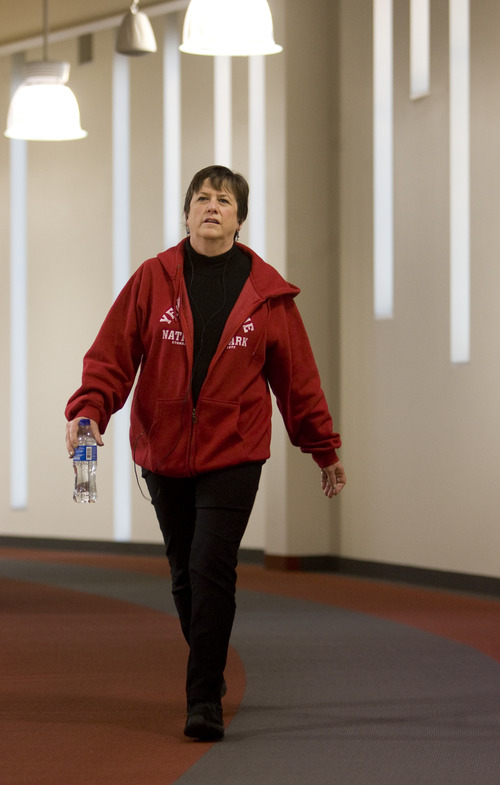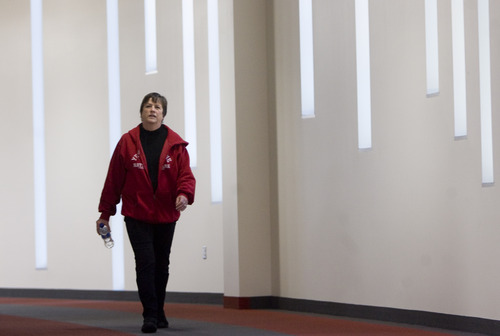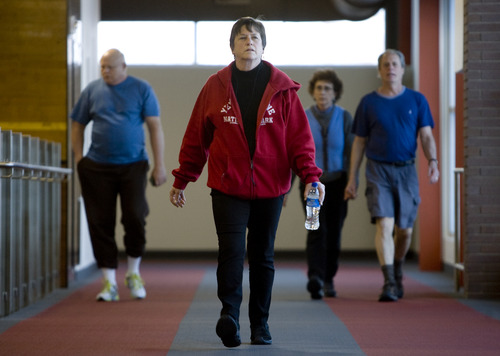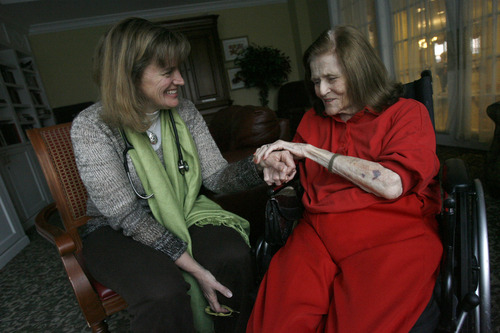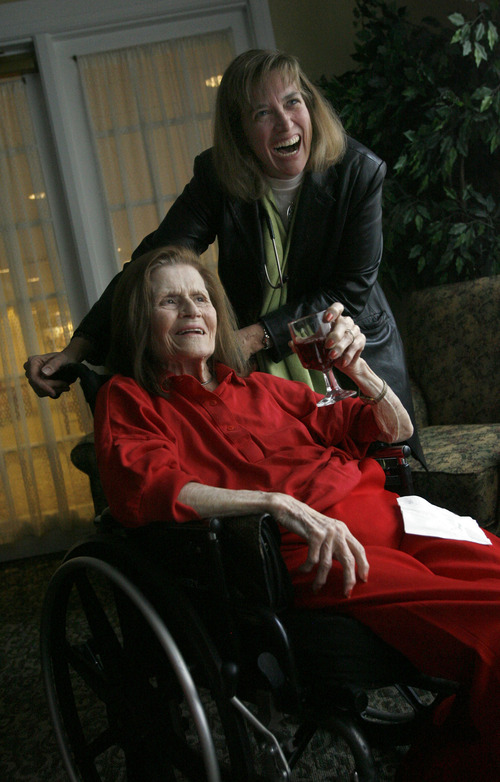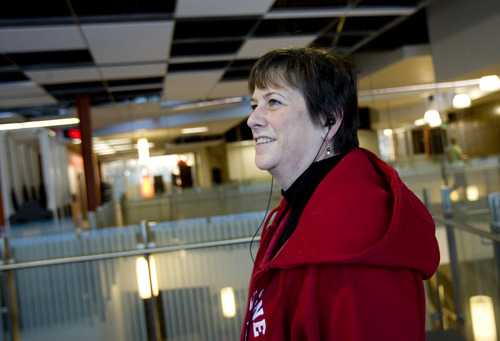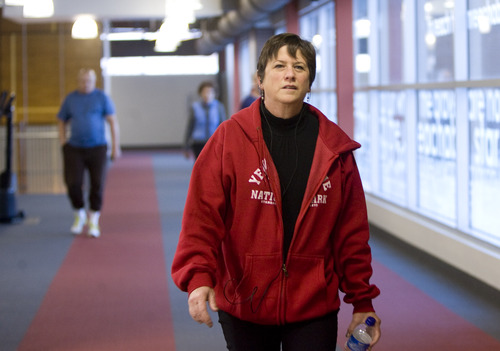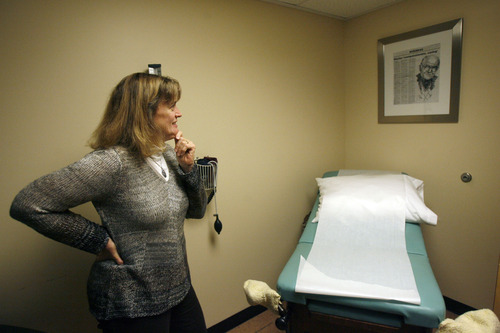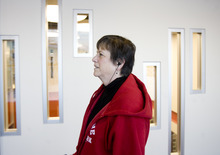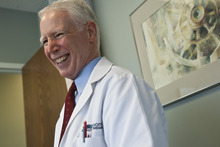This is an archived article that was published on sltrib.com in 2013, and information in the article may be outdated. It is provided only for personal research purposes and may not be reprinted.
Beth Hanlon grabs the stethoscope she keeps roped around the headrest of her car's passenger seat and strides through the double doors of a Salt Lake City nursing home, her first "house call" of the day.
"Hi, Nancy. How are you? Do you remember me? What's my name?" she asks, spotting her patient, 87-year-old Nancy Palmer, across the foyer in a wheelchair, sipping juice with a half-dozen other residents.
"You're my favorite person, that's all I know," says Palmer, who has dementia. "It's so nice of you to come, as busy as you are."
It's not every day that Hanlon makes house calls. But she's making more exceptions these days, now that she's seeing a fraction — about 350 — of the 2,500 patients she had a year ago.
In late December 2011, Hanlon and another internist at Alpine Medical Group, Yong Hui Ahn, joined a growing number of doctors embracing "concierge" health care.
Yearning for a return to the "Marcus Welby" style of doctoring practiced years ago by her father, who carried a weathered black bag and made house calls, Hanlon closed her traditional practice. She reopened at the same location under the banner of MDVIP, a "concierge" company in Boca Raton, Fla. Hanlon's patients pay her a $1,500 annual membership fee on top of copayments for their regular insurance, if they have it — and most do. In return, she promises them more personalized care and round-the-clock access.
The retainer has freed up Hanlon to spend more time with patients and to deliver care in novel ways that aren't typically reimbursed by insurers, changes she documented in a journal this past year.
She stages free exercise classes and health workshops, picks up the phone when patients call and coaches them on their weight-loss goals. Patients on vacation have sent her pictures of wounds and rashes for diagnosis. A developmentally disabled man with diabetes sends her his blood sugar readings weekly, and she emails him the correct dose of insulin to take.
Twenty years into her career, Hanlon is professionally recharged, practicing medicine the way she had always hoped – "the quintessential internist, always there when you need him, or her, in our case," she says.
She can't point to any particular "aha" diagnosis resulting from her switch. But she has forged deeper relationships with her patients, ties that promote healing.
Home visits have helped her see 16-year patients like Palmer through fresh eyes. Today, she has come to check on a rash that's been bothering Palmer. But walking the halls helps her appreciate what it takes to get to the home's dining room or exercise room.
Today, Palmer's hair is styled and her nails, freshly painted, match the red hue of her pantsuit. "I see you're taking part in social activities," notes Hanlon. "That's good."
The renewed intimacy has also enriched Hanlon's life, helping her cope with the loss of her father last summer.
"Today, a patient asked about my dad and his illness," reads Hanlon's final journal entry from last November. "She knew how close I had been to my dad, and I told her how much I miss him, and that I still say in my head, 'Gotta tell Dad about this.' Her kindness moved me to tears. ... This new element in my practice was a bit unforeseen, but I relish it."
—
A cure for 'burnout' • The first day of her new practice, on Dec. 20, 2011, Hanlon was excited and expecting things to be markedly different. But her time is largely spent doing what she's always done, with fewer patients and more time.
"I'm still busy and working the same number of hours. But the frenetic pace has slowed," she says. "It's not that I didn't provide good care before. I just feel less rushed."
She's also more productive. She's able to make more family "game nights" with her 16-year-old son because she's not preoccupied with research and phone calls that she wasn't able to get to during the day. She has more time to look into patients' problems and medication interactions, and communicate with consulting physicians.
Proponents say concierge medicine could heal what ails the health care system. For all the money that Americans pour into health care, the country has the worst health outcomes of any developed nation, says Tom Blue, executive director of the American Academy of Private Physicians, a professional association.
It's on the shoulders of primary care doctors to reverse that through better preventive care, but too many suffer from "burnout," Blue says. "They complain of the costs of indulging insurer chart audits and billing to collect a fraction of what they charge. They can't stay afloat. I hear it in every state."
Indeed, nine out of 10 physicians say they are unwilling to recommend health care as a profession, according to a 2012 poll by The Doctors Company, the nation's largest liability insurer.
Faced with new requirements to go digital and other federal health-reform rules, many are closing their practices and hiring on with hospital groups.
Based on current hiring trends, hospitals will account for more than 75 percent of physician hires within two years, predicts physician-recruiting firm Merritt Hawkins.
—
'Complete the circle' • Hanlon likes working solo. She started helping in her dad's office when she was 15, emulating her own practice after his but having to bend to modern pressures — not all of them industry-driven.
"My mom stayed at home and raised seven kids," says Hanlon, who is 53. "I have a very supportive husband, but even my dad would recognize it must be difficult being a working mom. He worked a lot harder than I did, for longer hours."
Months into Hanlon's new practice, her dad, who had been diagnosed with stomach cancer, started to decline. With the flexibility of her new practice, she was able to return home to Iowa for a week every month until he died last summer.
"All of us siblings wanted him to eat. We're so tied into food as a comfort in our culture. But he was so sick to his stomach that he couldn't even sit at the dinner table," she says. "His doctor, who is a saint, said, 'You know, you need to learn to nurture him in other ways. Sing to him, play music for him, read to him, or just sit and talk.' "
It's a strategy she's employed to ease worried relatives of patients in their final days.
A year ago she would often learn that a patient had died in the hospital. Now she's intimately involved in end-of-life decisions and care, one of the most richly rewarding experiences, she says.
"It allows me to 'complete the circle' in the caring of patients," she writes in her journal. "I have witnessed the transformation of families from disbelief or fear, to acceptance and tender care of their loved one. My personal experiences with my father through his illness have guided me immensely. I feel his presence as I sit with families."
—
Saving the solo practice • Blue predicts retainer-based practices will salvage the solo practice. There are about 4,400 concierge doctors in the U.S., up 30 percent since 2011.
"The election results really fanned the flames," Blue says. "But the true potential will be unleashed when people realize the access and white-glove treatment is a byproduct of the business model, not the price."
A relic of the 1990s, when some doctors charged annual sums as high as $15,000 to $25,000, concierge practices are no longer reserved for the ultra-rich, he says.
Today, groups such as MDVIP strive to remain affordable to the middle class.
Hanlon's rates won't increase for at least three years, says MDVIP marketing and innovation president Mark Murrison.
Members don't have to have insurance, though MDVIP recommends it for emergencies and acute specialty care. Hanlon works with some single working moms whose employers don't offer health benefits and whose pre-existing conditions make it impossible for them to buy coverage.
She has room for more patients, but she has met her enrollment goal. About half her patients are retirees on fixed incomes and Medicare; all but a few renewed their memberships this year.
"People are investing in their health," says Murrison, noting MDVIP added 100 doctors to its portfolio last year, which now spans 600 practices in 40 states. He predicts growth will remain strong as the Affordable Care Act prods millions to buy insurance, taxing the nation's shortage of primary care doctors.
"Issues that have plagued primary care, such as the ability to get into a doctor quickly, will be exacerbated. We'll see more midlevel physician's assistants providing care and longer waits, which will set us apart."
—
A step further • Critics say by winnowing their patients, concierge practices will worsen the shortage, especially for the poor.
Proponents argue primary care doctors are running out of choices. As insurance prices soar, more people are moving to high-deductible plans, which cover only big-ticket surgeries and emergencies.
"That means primary care services won't be covered, more people will delay care and show up later with more severe, harder to treat problems, causing costs to continue to spiral," says family practitioner Michael Jennings, who eschews insurance altogether.
Jennings, a licensed doctor for 25 years, quit his practice and in 2009 opened his own office in Millcreek, which doesn't accept insurance. For an annual flat rate — $1,800 for the first family member and less for others — his 150 to 180 patients can see him as often as needed. "We don't buy auto insurance to get the tires rotated or homeowners insurance to get the carpet cleaned," said the 63-year-old.
In some states, direct-pay practices face regulatory hurdles barring them from acting as insurers. Insurance companies, unlike such doctors, are required to prove they have funds on hand to pay for care.
But last year, with prodding from Jennings, Utah passed one of the most permissive laws in the country, allowing doctors to bill patients for services upfront.
The insurance lobby has stopped similar legislation in other states.
But Jennings says doctors who cheat patients won't stay in business for long. "I'm accountable to my patients," he says. "If I don't do a good job, they fire me."
Retainer-based practices like MDVIP, on the other hand, are a boon to insurers.
In December, MDVIP published data showing its patients are hospitalized 79 percent less than the average Medicare beneficiary and 72 percent less than the average commercially insured adult. The paper, in the American Journal of Managed Care, also showed MDVIP Medicare members were readmitted to hospitals less frequently for heart failure and pneumonia.
Another MDVIP-funded study, in the International Journal of Person Centered Medicine, showed its physicians score higher on federal quality measures for managing diabetes and heart conditions. Neither study, however, took into account the possibility that MDVIP caters to the ultra-health conscious.
—
'A real wake-up call' • Hanlon hasn't compiled data showing similar gains at her practice. But she's seen a difference in her patients' health.
"Some patients get to the stage they are ready to make lifestyle changes and want to make an appointment right away. Because of the model of my practice, they can get right in before they change their minds."
It worked for Catherine Barnhart, a patient of Hanlon's for 15 years. Barnhart says she agreed to pay the retainer because she couldn't imagine not having Hanlon as her doctor.
"The truth is, I can afford it, and I know a lot of people can't," says Barnhart, 55, who runs a nonprofit serving refugees. "But it was worth it."
With Hanlon's help, Barnhart lost 35 pounds last year. She is off her blood pressure medicine and feeling more energetic than she has in years.
"We had talked before about my needing to lose weight," she says. "But every time I tried a new diet or exercise plan I would lose steam after about three months of being miserable, starving myself and seeing no results."
The difference this time: eye-opening results from a blood test and Hanlon's coaching.
MDVIP equips its doctors with an armory of preventive screens that insurance doesn't normally cover unless a patient's symptoms warrant it. The tests are done yearly and are followed by an hourlong wellness check to explain results. It was at this wellness check that Barnhart, who has no family history of diabetes, learned she was borderline diabetic.
"My triglycerides were crazy," she says. "It was a real wake-up call. I thought, 'Oh, crap, I don't want to go there.' "
Hanlon gave her tips on keeping her portions small, cooking food from scratch and told her to buy a pedometer to track her activity level. She also would check in on Barnhart's progress with phone calls and emails.
"She said, stick to it or I'll kick your butt," says Barnhart. "It's one thing for your doctor to tell you to lose weight. It's another for her to tell you how to lose weight." —
Making the switch
Find The Salt Lake Tribune's earlier story about the launch of Beth Hanlon's concierge practice at http://bitly.com/YkQatF. —
A journal of change
Read excerpts from the journal Beth Hanlon kept during her first year of concierge practice at http://www.sltrib.com.



